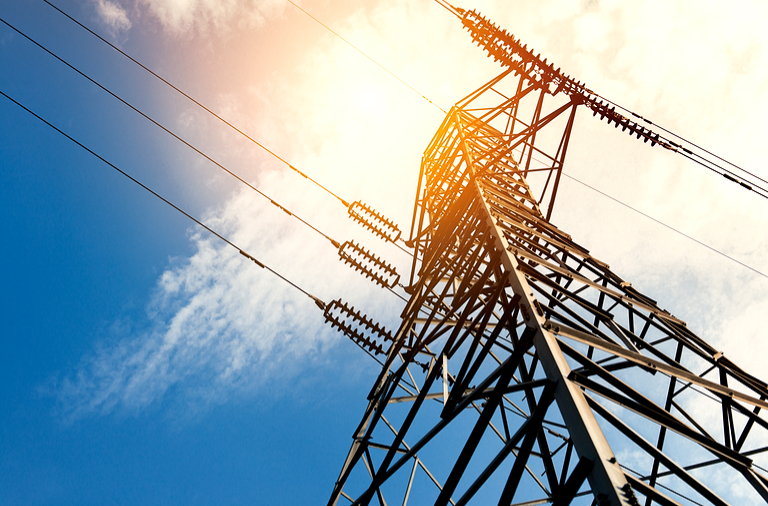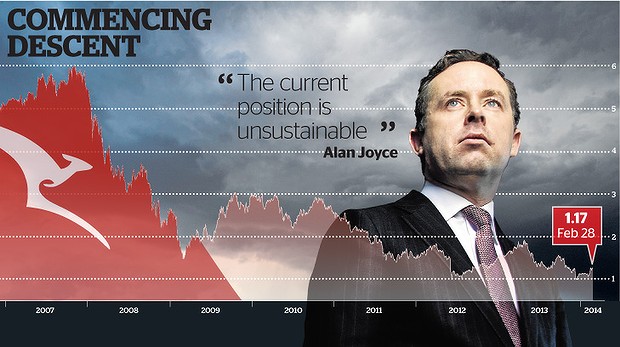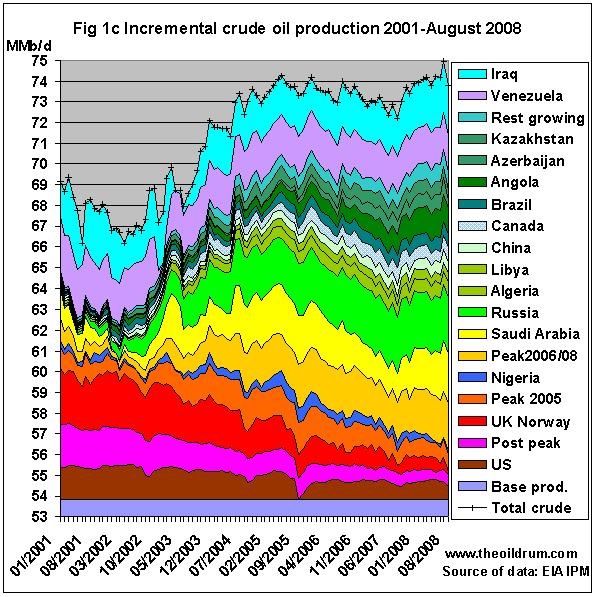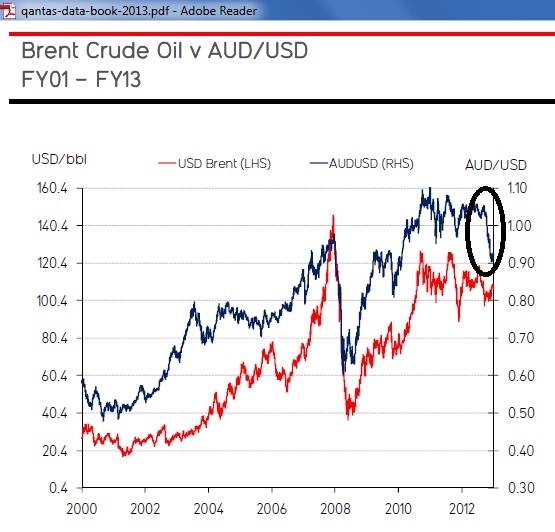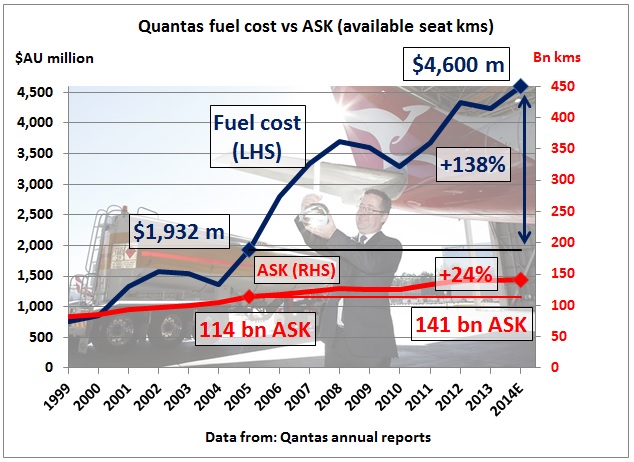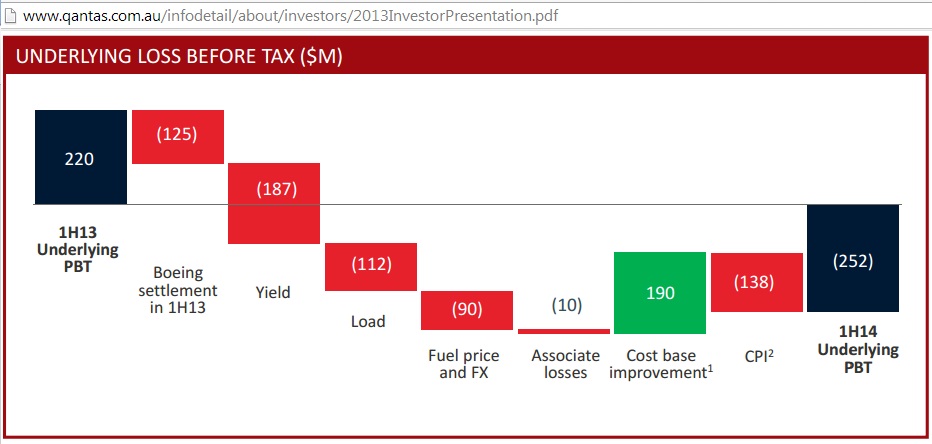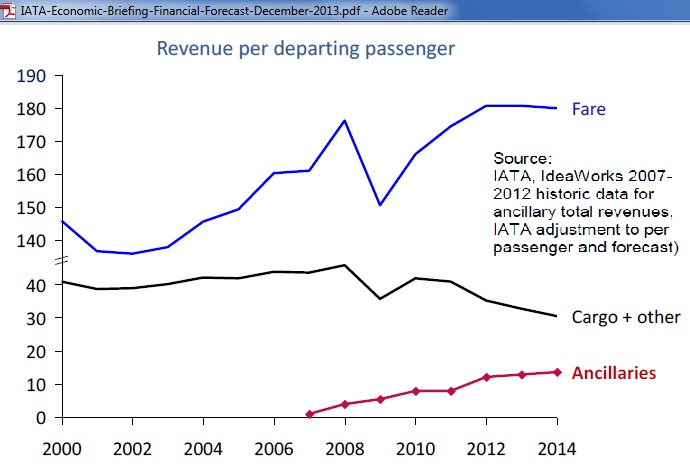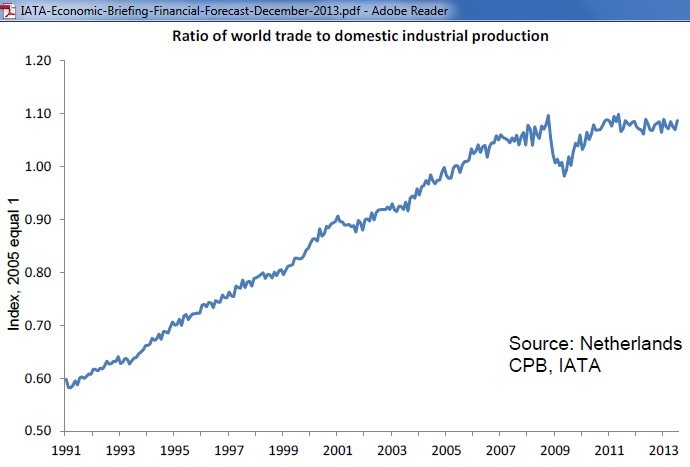The Sydney Morning Herald published the following article 2 days after Qantas CEO Alan Joyce announced a 1sthalf year loss of $252 million and job cuts of 5,000.
Mayday: how Qantas went from national icon to corporate tragedy
28/2/2014
The SMH article describes how Chairman Leigh Clifford selected Alan Joyce as successor for CEO Geoff Dixon in May 2008. That was the month when oil prices were skyrocketing towards $130 a barrel as a result of extra demand from China for the Olympic Games. After 2 years of declining crude oil production between 2005 and 2007 the world was approaching an Oilympic peak, both in production and prices, fuelled by Saudi Arabia.
Crude oil production up to August 2008, graph prepared for the oildrum blog.
In the World Energy Outlook 2004 the IEA estimated global oil demand to increase by around 1.6% pa (1.2 mb/d) which would have been an additional 4 mb/d of crude oil by mid 2008. Instead, crude production was just back to 2005 levels. This shortage of 4 mb/d was one of the main reasons for the oil price spike in 2008. At that point in time it was immaterial that oil production increased later from US shale oil. The damage to the economy was being done.
The Qantas annual report 2008 summed up the situation:
A new aviation environment
“Over the course of the year the crude oil price doubled from US$70 per barrel to US$140 a barrel. Through an effective hedging strategy, Qantas was able to partially mitigate the impact of this cost impost for the 2007/08 year. With fuel now comprising 35% of total cost, Qantas cannot be immune from the impacts of sustained high crude oil prices and higher jet fuel refining margins”
“Fuel costs increased by $265.3 million or 8%. The into-plane fuel price after hedging increased by 15.5 %. The volume of barrels consumed increased by 3.9% in line with higher flying hours, increasing costs by $141.7 million. The volume increase would have been $60 million higher had it not been for fuel conservation SFP initiatives delivered during the year. Stronger Australian currency movements reduced fuel costs by 430.6 million.”
2 months after that fateful Mayday in 2008, and while Qantas engineers strike over a pay rise, Dixon – who then had the job to ensure a smooth transition to Alan Joyce – came with another “constant shock” story:
Dixon warns oil shock will cost thousands of jobs
22/7/2008
GEOFF DIXON: Because the future is going to be very challenging – and I mean very challenging indeed – and here I will start with fuel because we believe this is where many airlines will end.
Oil of course is a finite natural resource and whether or not the world has reached peak oil is really a matter of debate. But there is no question that the cost of finding and extracting oil will continue to climb.
Today’s oil prices also derive from a long period of sustained global economic growth which you would know about, notably of course in China, India, and the Middle East. And this of course is the result of globalisation.
Now I’d say everyone in this room today is feeling the impact of high fuel prices. And while we welcome last week’s sudden drop in prices, we know there is no guarantee that this trend will continue.
http://www.abc.net.au/pm/content/2008/s2311337.htm
Dixon’s prediction hangs over Qantas ever since. As we know now oil prices dropped until February 2009 but then climbed up again. Since early 2011oil prices remain stubbornly high at around $100 WTI or $110 Brent. In this situation not much can be done with hedging. The last 3 years was the longest period ever when oil prices were that high.
And how about the global oil peak Geoff Dixon thought could be debated? We all know we’ll only be able to see that in the rear view mirror. Then there will be another continuing debate about how many years we’ll have to wait to be certain the peak is behind us, staring at declining but still zigzagging statistics in a nail-biting exercise. Governments obviously think that we can afford the luxury to wait and sit this out while waiting for technologies and market forces to rescue us. But that’s not the way things seem to evolve. What we see is that we have many production peaks or spikes around the over-all peaking and that high oil prices are like road-side bombs exploding here and there, none lethal but wearing the system down over time.
Let’s have a look at Qantas’ falling share price and compare it with oil prices:
Qantas’ share price (blue) plotted against Brent (red). Qantas shares were on a long-term declining trend while oil prices went up.
The trend was only interrupted in 2007 by a takeover bid from Airline Partners Australia (Allco Finance Group, Texas Pacific Group and Macquarie Bank, Onex Corporation) which failed in May 2007 when the US hedge fund Samuel Heyman did not accept the offer in time. The drama was described in this article:
Giant bluff goes badly wrong, no hedging it
At that time US hedge funds were busy coming to grips with the impacts of a bursting housing bubble, all made worse by rising petrol prices in the vast mortgage belts of US cities. The subprime mortgage crisis was in the making. The US recession started in December 2007.
The bid involved increasing Qantas’ debt 4-fold to $10.7 bn so it never had a chance at a time of an evolving oil shock. It was not just about missing a deadline.
So how has Qantas and its subsidiaries Jetstar survived that long?
What helped to limit fuel price increases was the high Australian dollar
This graph from the Qantas data book 2013 shows the Australian dollar as a commodity currency following movements of oil prices. That protected Australia from the harsh reality but also made it complacent. Years of adaptation have been lost. Only recently did the AUD drop out of this trend, increasing fuel bills.
On the other hand, being in the Asian commodity hot spot, comes at a price:
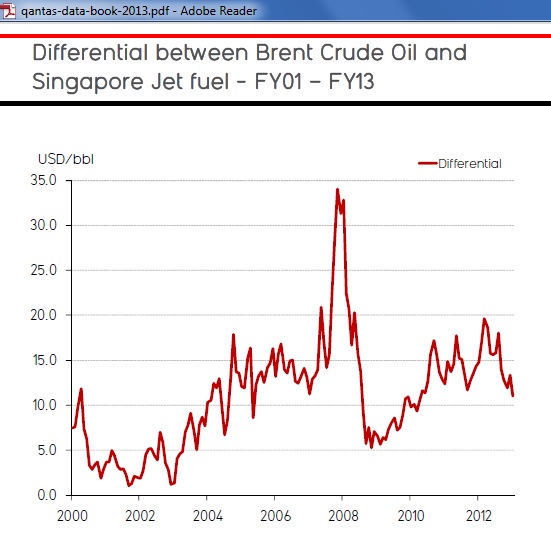
Asia pays more
So there are various factors at work. The result is that at end FY 2014, Qantas’ fuel bill will have increased to $4.6 bn.
Since 2005, when the process of global peaking started, fuel cost have increased by 138% while the physical product delivered, available seat kms, increased by only 24%
Let’s have a look at Qantas’ segment data.
Qantas International’s available seat kms peaked in 2005/06 and declined thereafter 25% by 2013. The load factor of 81.4% in 2007 did not improve in the following years. Jetstar International basically replaced the Qantas decline, but suffers from lower load factors of 76.6% in 2013. The only growth came from Jetstar Asia with a better load factor of 79%. It is a hard job to increase revenue seat kms.
Qantas struggles to fill A380 super jumbos during off-peak seasons
13/12/2013
Figures obtained by The Australian show some 484-seat A380s heading to Melbourne in November and early December had more than 200 of their 406 economy and premium economy seats unfilled a day before departure. In one case, more than half the business class cabin’s 64 flat-bed seats were also without paying customers as were eight of its 14 high-yielding first-class seats. The figures do not include staff travel or other subsidised tickets.
The situation was less dire on Dubai-Sydney routes where one plane had 131 unsold economy and premium economy seats and another 111. There were 11 business-class seats spare on one flight and just one on another while six and eight of the first-class suites were registered as available.
..
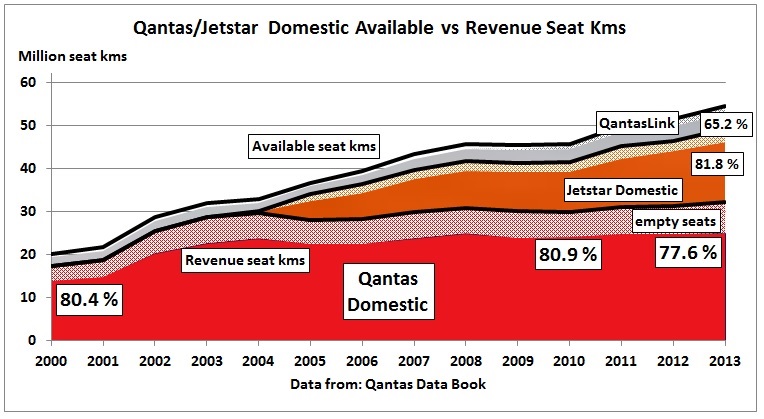
Qantas Domestic is basically flat (load factor recently slipped) with all growth taken up by Jetstar Domestic with higher load factor. But that growth in seat kms has not translated into higher earnings:
In the last 18 months Qantas domestic earnings decreased rapidly. Qantas International was much worse off and really bleeding. Even Jetstar’s earnings have gone negative.
The competitor Virgin has similar problems as was shown in this post:
This means that air fares are too low. It seems that market forces (competition) did not and do not solve the problem of higher fuel prices.
This graph from the 1H 2014 investor presentation shows that the fuel price increase and FX changes of $90 m was 36% of the total loss of 252 m. The lower load factor contribution of $112 m reflects subdued demand despite low fares. So a large part of the losses has been caused by high oil prices, directly or indirectly.
Globalisation
The fare problem is not limited to Qantas and Virgin. IATA found that revenue per departing passenger has remained flat since 2012
And IATA has even discovered that since 2008 an indicator for globalisation – after a short dip during the hot phase of the GFC and a rebound – has stayed flat since 2011:
Summary:
Higher oil prices impact on Qantas in various ways. They
(1) Increase fuel cost for operating aircraft
(2) Limit revenue from passengers who are already under financial pressure from rising fuel prices elsewhere in the economy
(3) Reduce profits and access to money markets to finance new, more fuel efficient aircraft
(4) Make it harder in general to implement a viable growth strategy which is necessary to pay back or roll over debt
Conclusion:
Although the final global crude oil peak may still be ahead, a 4-fold increase in oil prices since 2000 is already damaging the airline industry. Furthermore, this article has shown that particular past events during periods of production decline and/or high oil demand can permanently harm the financial position of companies exposed to oil price risks. We also see that the US shale oil boom has not fundamentally changed the situation. It is likely, however, that without US shale oil some airlines would have already gone into receivership. In the Australian context it makes no sense to even think about a 2nd Sydney airport.
Previous post:


